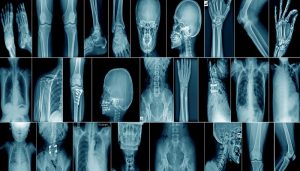
Medical X-rays are a type of imaging that is widely used in modern medicine. They were first discovered in 1895 by Wilhelm Conrad Roentgen, a German physicist who observed the ability of X-rays to penetrate human tissue and produce images of the body’s internal structures. Since then, X-ray technology has been widely adopted in medical settings, enabling healthcare professionals to diagnose a wide range of conditions.
Medical X-rays work by exposing a part of the body to a small dose of ionizing radiation. The X-rays pass through the body, and the energy that is absorbed by the different tissues is detected and converted into an image. The images produced by X-rays are commonly used to diagnose bone fractures, lung diseases, and other conditions that affect the internal organs.
X-rays are non-invasive, painless, and typically require no preparation from the patient. This makes them a valuable diagnostic tool that can be used to quickly identify a range of medical conditions. In addition, X-rays are relatively inexpensive and widely available, making them accessible to patients in both developed and developing countries.
Grab Sample PDF [Extended Version] Here>>> https://www.alliedmarketresearch.com/request-toc-and-sample/12422
One of the main advantages of medical X-rays is their ability to provide high-resolution images of the body’s internal structures. This allows healthcare professionals to make accurate diagnoses and develop effective treatment plans. For example, a chest X-ray can detect lung cancer or pneumonia, while a bone X-ray can identify a fracture or bone degeneration.
However, like any form of radiation, X-rays can be harmful if used improperly or excessively. In particular, repeated exposure to ionizing radiation can increase the risk of cancer and other health problems. To minimize this risk, medical professionals follow strict guidelines and protocols for the use of X-rays.
Advances in technology have also led to the development of new types of medical imaging, such as CT scans and MRI. These imaging technologies are more sophisticated than X-rays and can produce more detailed images of the body’s internal structures. However, X-rays remain an essential diagnostic tool in medicine, particularly in emergency situations where quick and accurate diagnoses are critical.
Top Trends in Medical X-Ray:
- Digital X-rays: Traditional X-rays use photographic film to produce images, but digital X-rays use electronic sensors. Digital X-rays provide better image quality, are easier to store and transfer, and can be more easily analyzed by computers.
- 3D X-rays: Three-dimensional X-rays, also known as computed tomography (CT) scans, create highly detailed images of the body’s internal structures. CT scans are useful for identifying complex medical conditions and providing precise guidance for surgical procedures.
- Portable X-ray machines: Advances in X-ray technology have made it possible to create portable X-ray machines that can be easily transported to different locations. These machines are especially useful in emergency situations or for patients who are unable to move to a traditional X-ray machine.
- Radiation dose reduction: While X-rays are generally safe, repeated exposure to ionizing radiation can increase the risk of cancer and other health problems. New technology and protocols have been developed to minimize radiation exposure during X-ray procedures, including low-dose techniques and protective shielding.
- AI-assisted X-rays: Artificial intelligence (AI) is being used to analyze X-ray images and identify abnormalities. This can lead to more accurate diagnoses and faster treatment times.
- Augmented reality: Augmented reality (AR) technology is being used to overlay X-ray images onto a patient’s body during surgery. This allows surgeons to see the patient’s internal structures in real-time, improving precision and reducing the risk of complications.
These trends in medical X-rays show that the technology is continually evolving and improving. By utilizing new technology and approaches, medical professionals can provide more accurate diagnoses, faster treatment, and better outcomes for patients.
In conclusion, medical X-rays are a vital diagnostic tool that has revolutionized modern medicine. By providing healthcare professionals with high-quality images of the body’s internal structures, X-rays have improved the accuracy of diagnoses and enabled effective treatment of a wide range of medical conditions. While X-rays can be harmful if used improperly, the benefits of this technology far outweigh the risks when used in accordance with established guidelines and protocols.
Contact Us:
David Correa
USA/Canada (Toll Free): +1-800-792-5285, +1-503-894-6022
help@alliedmarketresearch.com

